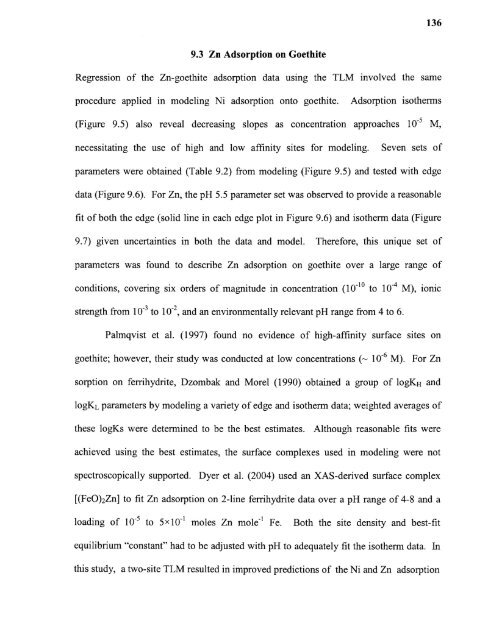Heavy metal adsorption on iron oxide and iron oxide-coated silica ...
Heavy metal adsorption on iron oxide and iron oxide-coated silica ...
Heavy metal adsorption on iron oxide and iron oxide-coated silica ...
You also want an ePaper? Increase the reach of your titles
YUMPU automatically turns print PDFs into web optimized ePapers that Google loves.
1369.3 Zn Adsorpti<strong>on</strong> <strong>on</strong> GoethiteRegressi<strong>on</strong> of the Zn-goethite <str<strong>on</strong>g>adsorpti<strong>on</strong></str<strong>on</strong>g> data using the TLM involved the sameprocedure applied in modeling Ni <str<strong>on</strong>g>adsorpti<strong>on</strong></str<strong>on</strong>g> <strong>on</strong>to goethite. Adsorpti<strong>on</strong> isotherms(Figure 9.5) also reveal decreasing slopes as c<strong>on</strong>centrati<strong>on</strong> approaches 10 -5 M,necessitating the use of high <strong>and</strong> low affinity sites for modeling. Seven sets ofparameters were obtained (Table 9.2) from modeling (Figure 9.5) <strong>and</strong> tested with edgedata (Figure 9.6). For Zn, the pH 5.5 parameter set was observed to provide a reas<strong>on</strong>ablefit of both the edge (solid line in each edge plot in Figure 9.6) <strong>and</strong> isotherm data (Figure9.7) given uncertainties in both the data <strong>and</strong> model. Therefore, this unique set ofparameters was found to describe Zn <str<strong>on</strong>g>adsorpti<strong>on</strong></str<strong>on</strong>g> <strong>on</strong> goethite over a large range ofc<strong>on</strong>diti<strong>on</strong>s, covering six orders of magnitude in c<strong>on</strong>centrati<strong>on</strong> (10 -10 to 10 -4 M), i<strong>on</strong>icstrength from 10 -3 to 10-2, <strong>and</strong> an envir<strong>on</strong>mentally relevant pH range from 4 to 6.Palmqvist et al. (1997) found no evidence of high-affinity surface sites <strong>on</strong>goethite; however, their study was c<strong>on</strong>ducted at low c<strong>on</strong>centrati<strong>on</strong>s (— 10 -6 M). For Znsorpti<strong>on</strong> <strong>on</strong> ferrihydrite, Dzombak <strong>and</strong> Morel (1990) obtained a group of logKH <strong>and</strong>logKL parameters by modeling a variety of edge <strong>and</strong> isotherm data; weighted averages ofthese logKs were determined to be the best estimates. Although reas<strong>on</strong>able fits wereachieved using the best estimates, the surface complexes used in modeling were notspectroscopically supported. Dyer et al. (2004) used an XAS-derived surface complex[(FeO)2Zn] to fit Zn <str<strong>on</strong>g>adsorpti<strong>on</strong></str<strong>on</strong>g> <strong>on</strong> 2-line ferrihydrite data over a pH range of 4-8 <strong>and</strong> aloading of 10-5 to 5x10 -1 moles Zn mole -1 Fe. Both the site density <strong>and</strong> best-fitequilibrium "c<strong>on</strong>stant" had to be adjusted with pH to adequately fit the isotherm data. Inthis study, a two-site TLM resulted in improved predicti<strong>on</strong>s of the Ni <strong>and</strong> Zn <str<strong>on</strong>g>adsorpti<strong>on</strong></str<strong>on</strong>g>
















